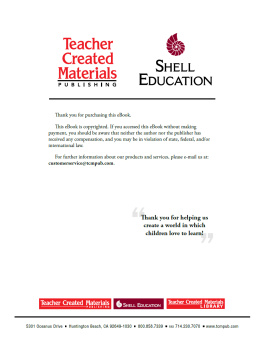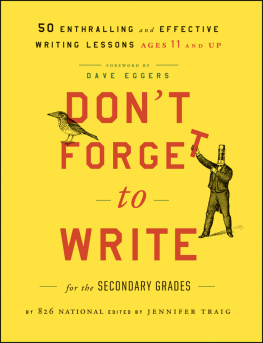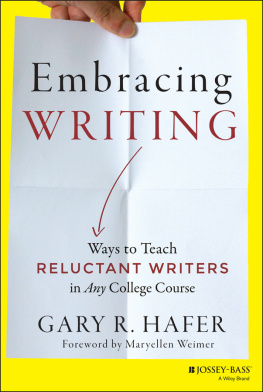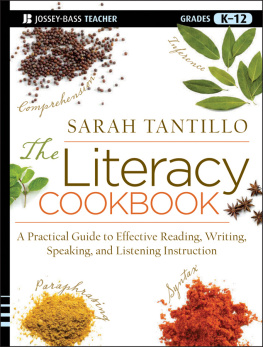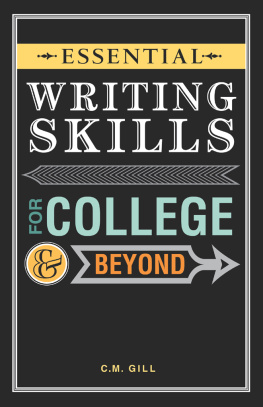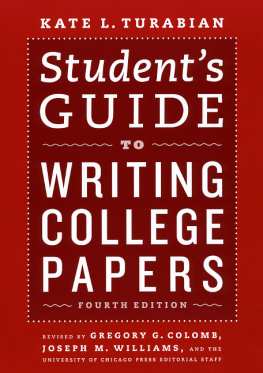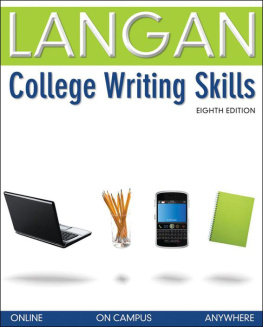
Publishing Credits
Dona Herweck Rice, Editor-in-Chief; Robin Erickson, Production Director;
Lee Aucoin, Creative Director; Timothy J. Bradley, Illustration Manager;
Sara Johnson, M.S.Ed., Senior Editor; Christine Dugan, Editor;
Jennifer Kim, M.A.Ed., Associate Education Editor; Leah Quillian, Assistant Editor;
Grace Alba, Designer; Corinne Burton, M.A.Ed., Publisher
Standards
2004 Mid-continent Research for Education and Learning (McREL)
2007 Teachers of English to Speakers of Other Languages, Inc. (TESOL)
2010 National Governors Association Center for Best Practices and Council of Chief State School Officers (CCSS)
Shell Education
5301 Oceanus Drive
Huntington Beach, CA 92649-1030
http://www.shelleducation.com
ISBN 978-1-4258-0920-1
ePUB ISBN 978-1-5457-0056-3
2013 Shell Educational Publishing, Inc.
The classroom teacher may reproduce copies of materials in this book for classroom use only. The reproduction of any part for an entire school or school system is strictly prohibited. No part of this publication may be transmitted, stored, or recorded in any form without written permission from the publisher.
Table of Contents
Introduction
The Importance of Writing
In recent years, many school districts and teachers referred to writing as the Neglected R and viewed reading as the path to literacy success. Today, as research has revealed more information about the fundamental connection between reading success and writing competency, we are realizing that the road to literacy is a two-way street (Graham and Hebert 2010). While working as literacy consultants, we encountered numerous, capable teachers struggling with the complexity of implementing rigorous writing instruction. We wrote this book to enable all teachers to implement a successful writing program with a high degree of teaching competency. The success enjoyed by many of the teachers using the materials in this book has relieved frustrations, rejuvenated careers, and rekindled enthusiasm for teaching.
This book was written to fulfill two major objectives. The first objective involves motivating teachers to value and incorporate writing instruction as an essential element of literacy development. It should help them implement best practices and simplify the planning of writing instruction. New writing standards have been applied by education leaders at every level. Ultimately, the responsibility for implementing these standards is placed on the classroom teacher. Historically, the lack of emphasis on writing instruction in teacher education programs has left teachers feeling woefully unprepared to teach students to write, particularly at a level which meets the expectations of the standards for writing. The burden of this responsibility and feelings of inadequacy have left both experienced and novice teachers feeling empty-handed and unprepared.
Since 2010, most states have adopted the Common Core State Standards (CCSS), which are designed to provide teachers and parents with a clear understanding of what students are expected to learn. Since the CCSS are newly adopted, many teachers have not received professional development to become familiar with the standards nor have they received resources for their instruction, particularly in the area of writing. Therefore, the second objective of this book is to assist teachers in becoming familiar with these standards for writing and provide resources to support the implementation of these standards in their classrooms. Getting to the Core of Writing provides lessons outlining four key areas of writing: Text Types and Purposes, Production and Distribution of Writing, Research, and Range of Writing. It offers suggestions to meet those standards in instruction during Writers Workshop. It also addresses how speaking and listening standards are easily practiced by engaging students in an interactive lesson format.
It is no secret that students become better writers by writing every day. This book contains the foundational structure and best practices that will guide teachers as they establish a daily Writers Workshop that includes consistent, structured instruction to engage students in the writing process. Beyond that, a flexible pacing guide is provided to aid in planning writing instruction.
It is our hope that this book provides teachers with all the tools needed to inspire and equip young writers in todays classrooms.
Richard, Jan, and Vickie
Traits of Quality Writing
The traits of quality writing continue to gain recognition as the language of successful writers. Educators at the Northwest Regional Educational Laboratory, now Education Northwest, searched for an accurate, reliable method of measuring student writing performance. Six attributes of good writing are identified in Seeing with New Eyes (Spandel 2005). These characteristics are used to inform and guide writing instruction:
Ideas are the heart of the message, the content of the piece, and the main theme.
Sentence fluency is the rhythm and flow of the language, the sound of word patterns, and the way in which the writing plays to the ear, not just to the eye.
Organization is the internal structure, the thread of central meaning, and the logical and sometimes intriguing pattern of ideas within a piece of writing.
Word choice is the use of rich, colorful, and precise language that moves and enlightens the reader.
Voice is the heart and soul, the magic, and the wit, along with the feeling and conviction of the individual writer that emerge through the words.
Conventions are how the writer uses mechanical correctness in the piecespelling, paragraphing, grammar and usage, punctuation, and capitalization.
Knowing and understanding the traits of quality writing supports teachers, students, and parents in thinking about writing and understanding what makes for writing success. Even in the early grades, students can communicate and recognize the characteristics of quality writing. The works of Ruth Culham (2008) and Vicki Spandel (2008) emphasize the value and benefits of using these traits to provide a common languagea writers vocabulary for thinking, speaking, and working like writers (Spandel 2008, 7)to enrich instruction and assessment in any classroom.
The value and importance of using this trait language in writing instruction is well supported by research (Gentry 2006). It is particularly important when working with students in the early grades to provide instructional tools to support students different learning styles. In Getting to the Core of Writing, the traits are personified through student-friendly characters. Each of the characters represents a different writing trait, and collectively they are referred to as the Traits Team (traitsteam.pdf). Students are introduced to the individual team members through the mini-lessons. The Traits Team becomes a valuable tool for a Writers Workshop experience. A more detailed description and poster of each Traits Team member is provided in the introduction to each trait section.
The Reading and Writing Connection
Students writing abilities often shift in third through sixth grade as student readers make a giant cognitive leap from learning to read to reading to learn. Students have likely advanced through all five phases of beginning reading and writing development, attaining a degree of independence as both readers and writers by the time they enter third grade.

